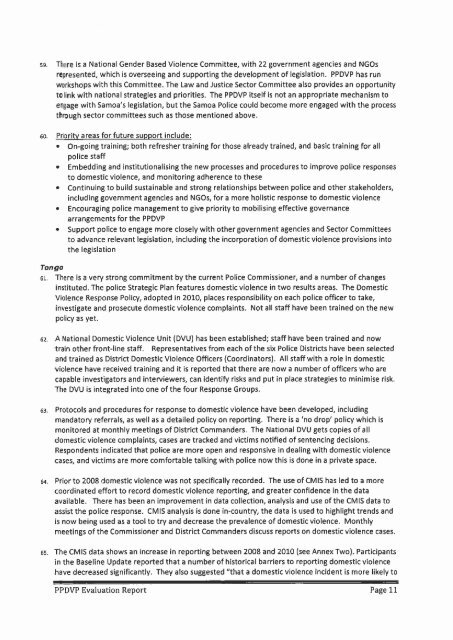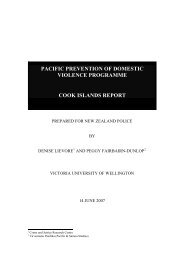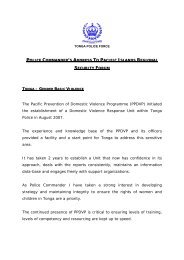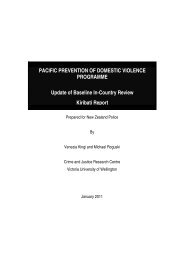PPDVP Evaluation Report - Pacific Prevention of Domestic Violence ...
PPDVP Evaluation Report - Pacific Prevention of Domestic Violence ...
PPDVP Evaluation Report - Pacific Prevention of Domestic Violence ...
You also want an ePaper? Increase the reach of your titles
YUMPU automatically turns print PDFs into web optimized ePapers that Google loves.
59. There is a National Gender Based <strong>Violence</strong> Committee, with 22 government agencies and NGOsrepresented, which is overseeing and supporting the development <strong>of</strong> legislation. <strong>PPDVP</strong> has runworkshops with this Committee. The Law and Justice Sector Committee also provides an opportunitytolink with national strategies and priorities. The <strong>PPDVP</strong> itself is not an appropriate mechanism toengage with Samoa's legislation, but the Samoa Police could become more engaged with the processthrough sector committees such as those mentioned above.60. Prioritv areas for future su~port include:On-going training; both refresher training for those already trained, and basic training for allpolice staffEmbedding and institutionalising the new processes and procedures to improve police responsesto domestic violence, and monitoring adherence to theseContinuing to build sustainable and strong relationships between police and other stakeholders,including government agencies and NGOs, for a more holistic response to domestic violenceEncouraging police management to give priority to mobilising effective governancearrangements for the <strong>PPDVP</strong>Support police to engage more closely with other government agencies and Sector Committeesto advance relevant legislation, including the incorporation <strong>of</strong> domestic violence provisions intothe legislationTonga61. There is a very strong commitment by the current Police Commissioner, and a number <strong>of</strong> changesinstituted. The police Strategic Plan features domestic violence in two results areas. The <strong>Domestic</strong><strong>Violence</strong> Response Policy, adopted in 2010, places responsibility on each police <strong>of</strong>ficer to take,investigate and prosecute domestic violence complaints. Not all staff have been trained on the newpolicy as yet.62. A National <strong>Domestic</strong> <strong>Violence</strong> Unit (DVU) has been established; staff have been trained and nowtrain other front-line staff. Representatives from each <strong>of</strong> the six Police Districts have been selectedand trained as District <strong>Domestic</strong> <strong>Violence</strong> Officers (Coordinators). All staff with a role in domesticviolence have received training and it is reported that there are now a number <strong>of</strong> <strong>of</strong>ficers who arecapable investigators and interviewers, can identify risks and put in place strategies to minimise risk.The DVU is integrated into one <strong>of</strong> the four Response Groups.63. Protocols and procedures for response to domestic violence have been developed, includingmandatory referrals, as well as a detailed policy on reporting. There is a 'no drop' policy which ismonitored at monthly meetings <strong>of</strong> District Commanders. The National DVU gets copies <strong>of</strong> alldomestic violence complaints, cases are tracked and victims notified <strong>of</strong> sentencing decisions.Respondents indicated that police are more open and responsive in dealing with domestic violencecases, and victims are more comfortable talking with police now this is done in a private space.64. Prior to 2008 rjomestic violence was not specifically recorded. The use <strong>of</strong> CMIS has led to a morecoordinated effort to record domestic violence reporting, and greater confidence in the dataavailable. There has been an improvement in data collection, analysis and use <strong>of</strong> the CMlS data toassist the police response. CMlS analysis is done in-country, the data is used to highlight trends andis now being used as a tool to try and decrease the prevalence <strong>of</strong> domestic violence. Monthlymeetings <strong>of</strong> the Commissioner and District Commanders discuss reports on domestic violence cases.65. The CMlS data shows an increase in reporting between 2008 and 2010 (see Annex Two). Participantsin the Baseline Update reported that a number <strong>of</strong> historical barriers to reporting domestic violencehave decreased significantly. They also suggested "that a domestic violence incident is more likely to- - ~<strong>PPDVP</strong> <strong>Evaluation</strong> <strong>Report</strong> Page 11














